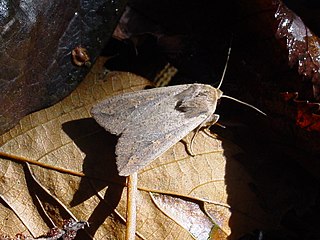Related Research Articles

Metamorphosis is a biological process by which an animal physically develops including birth transformation or hatching, involving a conspicuous and relatively abrupt change in the animal's body structure through cell growth and differentiation. Some insects, fish, amphibians, mollusks, crustaceans, cnidarians, echinoderms, and tunicates undergo metamorphosis, which is often accompanied by a change of nutrition source or behavior. Animals can be divided into species that undergo complete metamorphosis ("holometaboly"), incomplete metamorphosis ("hemimetaboly"), or no metamorphosis ("ametaboly").

Lepidoptera is an order of insects that includes butterflies and moths. About 180,000 species of the Lepidoptera are described, in 126 families and 46 superfamilies, 10 percent of the total described species of living organisms. It is one of the most widespread and widely recognizable insect orders in the world. The Lepidoptera show many variations of the basic body structure that have evolved to gain advantages in lifestyle and distribution. Recent estimates suggest the order may have more species than earlier thought, and is among the four most species-rich orders, along with the Hymenoptera, Diptera, and Coleoptera.

Ecdysone is a prohormone of the major insect molting hormone 20-hydroxyecdysone, which is secreted from the prothoracic glands. It is of steroidal structure. Insect molting hormones are generally called ecdysteroids. Ecdysteroids act as moulting hormones of arthropods but also occur in other related phyla where they can play different roles. In Drosophila melanogaster, an increase in ecdysone concentration induces the expression of genes coding for proteins that the larva requires, and it causes chromosome puffs to form in polytene chromosomes. Recent findings in the laboratory of Chris Q. Doe have found a novel role of this hormone in regulating temporal gene transitions within neural stem cells of the fruit fly.
Allatostatins are neuropeptide hormones in insects and crustacea. They have a twofold function: they both inhibit the generation of juvenile hormone and reduce their food intake. They are therefore putative targets for insecticide research.
Juvenile hormones (JHs) are a group of acyclic sesquiterpenoids that regulate many aspects of insect physiology. The first discovery of a JH was by Vincent Wigglesworth. JHs regulate development, reproduction, diapause, and polyphenisms.The chemical formula for juvenile hormone is .

In animal dormancy, diapause is the delay in development in response to regular and recurring periods of adverse environmental conditions. It is a physiological state with very specific initiating and inhibiting conditions. The mechanism is a means of surviving predictable, unfavorable environmental conditions, such as temperature extremes, drought, or reduced food availability. Diapause is observed in all the life stages of arthropods, especially insects.
Holometabolism, also called complete metamorphosis, is a form of insect development which includes four life stages: egg, larva, pupa, and imago. Holometabolism is a synapomorphic trait of all insects in the superorder Endopterygota. Immature stages of holometabolous insects are very different from the mature stage. In some species the holometabolous life cycle prevents larvae from competing with adults because they inhabit different ecological niches. The morphology and behavior of each stage are adapted for different activities. For example, larval traits maximize feeding, growth, and development, while adult traits enable dispersal, mating, and egg laying. Some species of holometabolous insects protect and feed their offspring. Other insect developmental strategies include ametabolism and hemimetabolism.

The brown-banded cockroach is a species of small cockroach, measuring about 10 to 14 mm long and the most well-known in the genus Supella. It is tan to light brown and has two light-colored bands across the wings and abdomen, they may sometimes appear to be broken or irregular but are quite noticeable. The bands may be partly obscured by the wings. The male has wings that cover the abdomen, while the female has wings that do not cover the abdomen completely. The male appears more slender than the female, the female appears wider.

A black fly or blackfly is any member of the family Simuliidae of the Culicomorpha infraorder. It is related to the Ceratopogonidae, Chironomidae, and Thaumaleidae. Over 2,200 species of black flies have been formally named, of which 15 are extinct. They are divided into two subfamilies: Parasimuliinae contains only one genus and four species; Simuliinae contains all the rest. Over 1,800 of the species belong to the genus Simulium.

Rhodnius prolixus is the principal triatomine vector of the Chagas parasite due to both its sylvatic and domestic populations in northern South America as well as to its exclusively domestic populations in Central America. It has a wide range of ecotopes, mainly savanna and foothills with an altitude of between 500 to 1,500 metres above sea level and temperatures of 16 to 28 °C. Sylvatic R. prolixus, as virtually all Rhodnius spp., is primarily associated with palm tree habitats and has a wide range of hosts including birds, rodents, marsupials, sloths, and reptiles.

Calliphora vomitoria, known as the blue bottle fly, orange-bearded blue bottle, or bottlebee is a species of blow fly, a species in the family Calliphoridae. Calliphora vomitoria is the type species of the genus Calliphora. It is common throughout many continents including Europe, Americas, and Africa. They are fairly large flies, nearly twice the size of the housefly, with a metallic blue abdomen and long orange setae on the gena.

Agrotis ipsilon, the dark sword-grass, black cutworm, greasy cutworm, floodplain cutworm or ipsilon dart, is a small noctuid moth found worldwide. The moth gets its scientific name from black markings on its forewings shaped like the letter "Y" or the Greek letter upsilon. The larvae are known as "cutworms" because they cut plants and other crops. The larvae are serious agricultural pests and feed on nearly all varieties of vegetables and many important grains.
Insect physiology includes the physiology and biochemistry of insect organ systems.

The enzyme juvenile hormone esterase (EC 3.1.1.59, systematic name methyl-(2E,6E,10R)-10,11-epoxy-3,7,11-trimethyltrideca-2,6-dienoate acylhydrolase, JH esterase) catalyzes the hydrolysis of juvenile hormone:

Mythimna unipuncta, the true armyworm moth, white-speck moth, common armyworm or rice armyworm, is a nocturnal agricultural pest belonging to the family Noctuidae. This moth is also commonly referred to by the scientific name Pseudaletia unipuncta. The species was first described by Adrian Hardy Haworth in 1809. Mythimna unipuncta is found in the Americas and in parts of Europe, Africa and Asia. Its original distribution is North and South America. It has been introduced to other places from there. They are known as armyworms because the caterpillars move in lines as a massive group, like an army, from field to field, damaging crops.
Prothoracicotropic hormone (PTTH) was the first insect hormone to be discovered.The chemical symbol for prothoracicotropic hormone is (C64H102N16O19S2). It was originally described simply as "brain hormone" by early workers such as Stefan Kopeć (1922) and Vincent Wigglesworth (1934), who realized that ligation of the head of immature insects could prevent molting or pupation of the body region excluded from the head if the ligation was performed before a critical age in the lifestage was reached. After a certain point the ligation had no effect and both sections of the insect would molt or pupate. However, implantation of a conspecific brain to a sessile ligated abdomen or an abdomen under diapause would induce molting or pupation. Thus, the brain was originally thought to be the source of the hormone that induces molting in insects.

Insect morphology is the study and description of the physical form of insects. The terminology used to describe insects is similar to that used for other arthropods due to their shared evolutionary history. Three physical features separate insects from other arthropods: they have a body divided into three regions, have three pairs of legs, and mouthparts located outside of the head capsule. It is this position of the mouthparts which divides them from their closest relatives, the non-insect hexapods, which includes Protura, Diplura, and Collembola.
Neurosecretion is the storage, synthesis and release of hormones from neurons. These neurohormones, produced by neurosecretory cells, are normally secreted from nerve cells in the brain that then circulate into the blood. These neurohormones are similar to nonneural endocrine cells and glands in that they also regulate both endocrine and nonendocrine cells. Neurosecretion cells synthesize and package their product in vesicles and exocytose them at axon endings just as normal neurons do, but release their product farther from their target than normal neurons, typically releasing their neurohormones into the circulatory system to reach their distant targets.
Aedes taeniorhynchus, or the black salt marsh mosquito, is a mosquito in the family Culicidae. It is a carrier for encephalitic viruses including Venezuelan equine encephalitis and can transmit Dirofilaria immitis. It resides in the Americas and is known to bite mammals, reptiles, and birds. Like other mosquitoes, Ae. taeniorhynchus adults survive on a combination diet of blood and sugar, with females generally requiring a blood meal before laying eggs.
Juvenile hormone acid O-methyltransferase (JHAMT) is a ~33 kDa enzyme that catalyzes the conversion of inactive precursors of Juvenile hormones (JHs) to active JHs in the final stages of JH biosynthesis in the corpora allata of insects. More specifically, the enzyme catalyzes the transfer of a methyl group from S-adenosyl-L-methionine (SAM) to the carboxylate group of JH precursors.
References
- ↑ Vitamins and Hormones: v. 14: Advances in Research and Applications, edited by Richard Harris, 1956, from Elsevier
- ↑ Insect Hormones Archived 2010-01-03 at the Wayback Machine at John W. Kimball's Biology-Pages.info
- ↑ THE HOMOLOGIES OF THE RING GLAND OF DIPTERA BRACHYCERA, Annals of the Entomological Society of America, Volume 36, Number 1, March 1943, pp. 1-10, by M.F. Day
- ↑ Insect Hormones, page 13, by H. Fredrik Nijhout, 1994, Princeton University Press